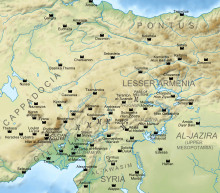Kemah (Turkey)
| Kemah | ||||
|
||||

|
||||
| Basic data | ||||
|---|---|---|---|---|
| Province (il) : | Erzincan | |||
| Coordinates : | 39 ° 36 ' N , 39 ° 2' E | |||
| Height : | 1130 m | |||
| Residents : | 2,781 (2011) | |||
| Telephone code : | (+90) 446 | |||
| Postal code : | 24400 | |||
| License plate : | 24 | |||
| Structure and administration (as of 2019) | ||||
| Structure : | 10 malls | |||
| Mayor : | Osman Kemal Aslan ( MHP ) | |||
| Kemah County | ||||
| Residents : | 8,167 (2011) | |||
| Surface: | 2,311 km² | |||
| Population density : | 4 inhabitants per km² | |||
| Kaymakam : | Ahmet Karaaslan | |||
| Website (Kaymakam): | ||||
Kemah ( Armenian Gamax , Zazaisch Kemax ) is a city and administrative center of the district of the same name in the Turkish province of Erzincan . The place is located about 50 kilometers west of the provincial capital Erzincan and is home to about a third (2018: 34.095%) of the district's population. The present-day city lies at the foot of the old fortress of Kemah on the railway line from Erzincan to Sivas .
The name Kemah is common today and is derived from the Greek word Κάμαχα . The names Kamch or Kamach appeared in the Arabic sources of the Middle Ages.
district
The district is located in the west of the province and borders the İliç district in the west, Refahiye district in the north and the central district ( Merkez ) of Erzincan in the east. In the south, Ovacık County ( Tunceli Province ) forms the border. Kemah County has - like most of the counties in the east and west of the province - a very low population density, the lowest in the province.
In addition to the district town, the district also consists of 73 villages ( Köy ) with an average of 74 residents. Kerer is the largest village with 361 inhabitants.
history
In the early Middle Ages, Kemah was a border fortress between the Byzantine Empire and the Umayyads (later also Abbasids ) and often alternated between the two sides. The first Arab attack on the region under Habib ibn Maslama was a failure for the Arabs. During the third attack in 678/679, the Arabs were able to take the fortress, but lost it again after a short time. After several back and forth, the Byzantines were able to control Kemah between 793 and the Battle of Manzikert in 1071. The first Turkish raids took place in 1057/58. After the defeat of the Byzantines in Manzikert, Turkish principalities ( Beylik ) were founded in Anatolia . Kemah became part of the Beylik Mengücek . Founder was the general Mengücek Ghazi of the same name, who received the areas around Erzincan and Kemah as a reward for his services. Mengücek Ghazi died in 1118 and was buried in Kemah.
The Mengücek were later harassed by the Rum Seljuks , until their sultan Kai Kobad I first conquered Erzincan in 1225 and then Kemah in 1228, thus ending the Beylik. The last Mengücek ruler had tried to forge an alliance against Kai Kobad I with the Saltukids of Erzurum and Jalal ad-Din , but failed. The Rum Seljuks were subjugated by the Mongols in 1243 and Kemah became part of the Ilchanate . After the chaotic end of the Mongolian Ilkhan, their empire in Anatolia split into several parts. Kemah was ruled by the Eretna and then by Kadi Burhan al-Din . The Ottomans under Sultan Bayezid I conquered large parts of eastern Anatolia and eliminated Kadi Burhan al-Din. You should rule Kemah by the end of World War I , albeit with interruptions. Bayazid I lost part of his empire to Timur in 1402 and was even captured himself. In 1515 the Ottomans took back Kemah, which in the meantime belonged to the Aq Qoyunlu and Safavids .
In Kemah, during the Armenian genocide between June 10 and 14, 1915, 25,000 Armenians were killed in four days by throwing the victims into a steep gorge and into the Euphrates River .
Personalities
- Deniz Barış (* 1977), German-Turkish football player
- Hakan Taş (* 1966), German-Turkish politician
- Bahadır Taşdelen (* 1990), Turkish soccer player
swell
- The Encyclopaedia of Islam. New Edition , article Kemakh by CH Imber
Web links
Individual evidence
- ↑ a b Türkiye Nüfusu İl ilçe Mahalle Köy Nüfusları , accessed on June 14, 2019
- ↑ Clive Foss, Alexander Petrovich Kazhdan: Oxford Dictionary of Byzantium . Ed .: Oxford University Press. New York and Oxford, United Kingdom 1991, ISBN 978-0-19-504652-6 , pp. 1097 .
- ^ The forgotten Holocaust: The Armenian massacre that inspired Hitler. In: Part of The Daily Mail, The Mail on Sunday & Metro Media Group. Associated Newspapers Ltd, October 11, 2007, accessed October 8, 2011 : "In four days alone, from June 10-14, 1915, the gangs 'eliminated' some 25,000 people in the Kemah Erzincan area alone."
- ^ Raymond H. Kévorkian : The Armenian genocide: a complete history . IB Tauris, London 2011, ISBN 1-84885-561-3 , pp. 309-310 (accessed October 8, 2011).
- ^ Raymond H. Kévorkian: The Extermination of Ottoman Armenians by the Young Turk Regime (1915-1916). In: Online Encyclopedia of Mass Violence. June 3, 2008, accessed on October 8, 2011 : “At a point two hours from the town, the men are taken aside and eliminated. 2,833 infants from the kaza of Bayburt are drowned in the Euphrates in the midst of the gorges of Kemah. "



